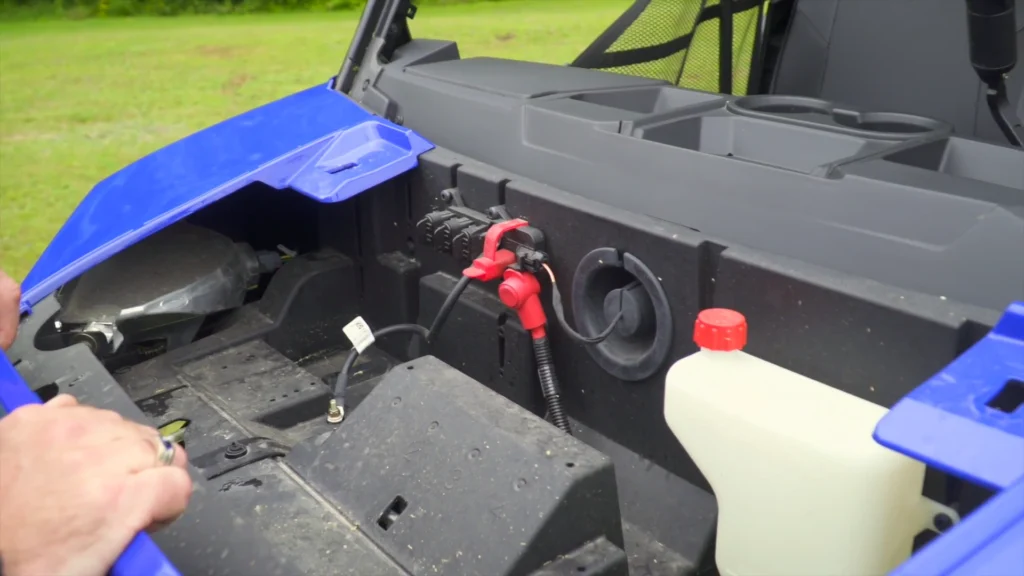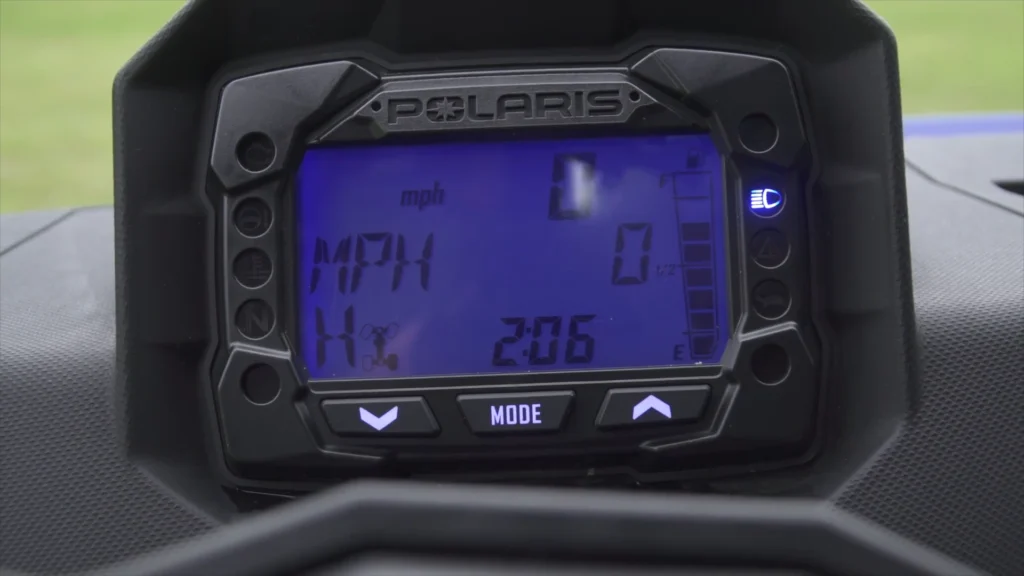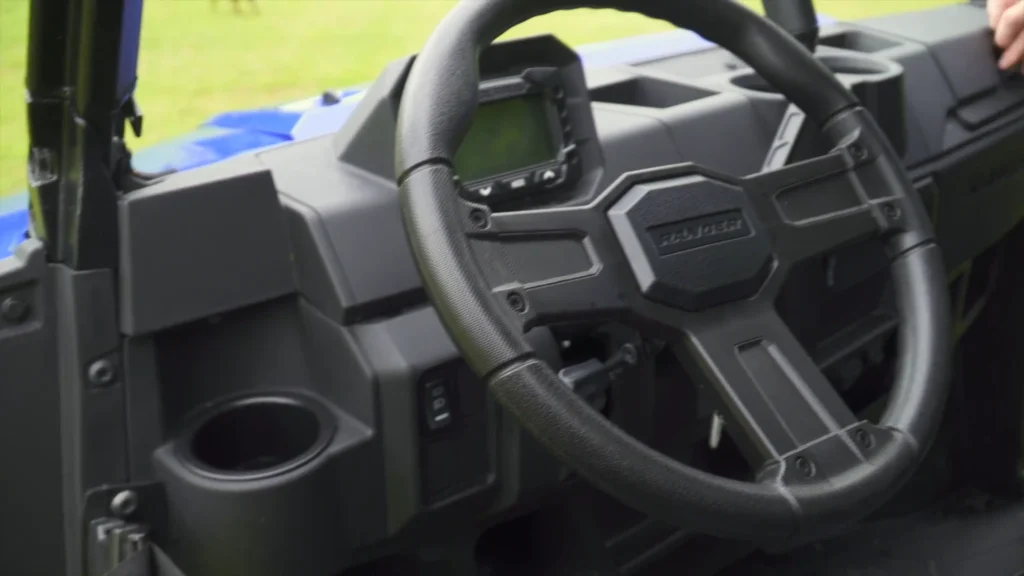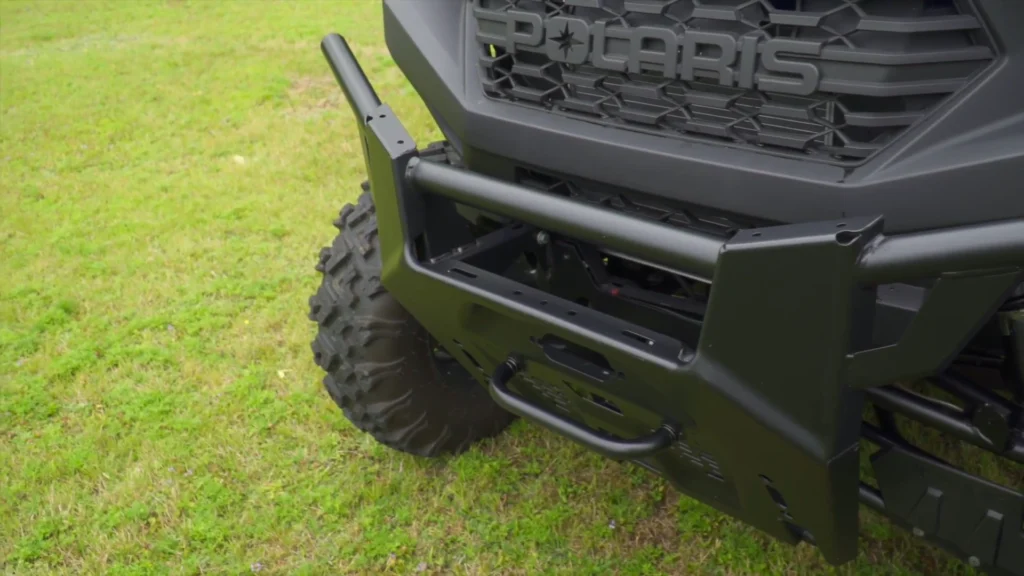Bottom-Line
I recommend the Ranger 1000 if you want a work-first UTV that fits gates and keeps costs in check. It makes 61 hp, is 62.5 in wide with 12 in of clearance, tows 2,500 lb, and hauls 1,000 lb in a 36.75 × 54 × 11.5 in bed. If you need more power and taller tires, cross-shop the XP 1000.
Polaris Ranger 1000 (3-seat)

| Year | Trim | HP | Width | Ground clearance | Tires (stock) | Bed L×W×H | Bed rating | Payload | Towing | Dry weight | Service cadence | Notes |
|---|---|---|---|---|---|---|---|---|---|---|---|---|
| 2025 | EPS | 61 | 62.5 in | 12 in | 25×10-12 F / 25×11-12 R (Carlstar 489) | 36.75 × 54 × 11.5 in | 1,000 lb | 1,500 lb | 2,500 lb | 1,485 lb | 200 hr / 2,000 mi / 6 mo after break-in | Gen 2 Automatic PVT; True AWD/2WD/Turf |
| 2025 | Premium | 61 | 62.5 in | 12.5 in | 26×9-12 F / 26×11-12 R (PXT 2.0) | 36.75 × 54 × 11.5 in | 1,000 lb | 1,500 lb | 2,500 lb | 1,544 lb | 200 hr / 2,000 mi / 6 mo after break-in | Factory poly roof and Polaris HD 4,500 lb synthetic-rope winch standard |
Who this machine is for

- Ranch and farm work. You need a bench, a real dump bed, and easy service points. This fits. It tows 2,500 lb and hauls 1,000 lb. Bed is 36.75 × 54 × 11.5 in.
- Narrow gates and barns. It is 62.5 in wide. It fits most 63 in gates without drama.
- Mixed trail and chores. Turning radius is tight. Cab stays quiet enough for long days.
- DIY maintenance. Pop-out grille for radiator cleaning. Tilt bed for access. Labeled power bus bar.
- Value buyers. You want a work-first rig at the lower entry price, not every premium add-on.
My take: I had several short rides. Pulling a small trailer and weaving through trees felt easy. Owners report the same on farms and wood lots, with the dump bed and under-seat storage getting daily use.
Engine feel and drivability

The 61 hp tune is aimed at work. Takeoff is smooth if you roll into the throttle. On flat ground with a small wagon, it feels relaxed. On long grades with weight, it will work harder and downshift sooner than an XP 1000. True AWD hooks up well. Turf Mode protects lawns and barn aisles when you need it.
Owner themes I back up: many call it durable for firewood, plowing, and fence work if you keep up on service. A common tip is to keep a spare belt and tool on board and to learn the CVT drain after water crossings. Another simple habit is to blow out the radiator fins from the fan side using the removable front grille. Those small things keep temps and belts happy.
Transmission and shifting
It runs Gen 2 Automatic PVT with H/L/N/R/P. Creep control is good once the belt is warm. Keep throttle steady when backing a trailer. Belt care matters: avoid long, hot slips; break in a new belt; and inspect the cover drains after deep water.
Some owners fit a clutch kit to smooth low-rpm engagement on older or base setups. Set expectations on the shifter feel. The widely reported lighter shifter and return-to-center EPS are 2025 XP 1000 updates, not this base Ranger 1000. If that matters to you, cross-shop trims before you buy.
Size, seating, storage, and cab

Width is 62.5 in. Ground clearance is 12–12.5 in by trim. It seats three on a bench. Storage is a win: dash bins, under-seat space, and spots for tools. The pop-out front grille makes radiator cleaning fast. The cargo box is deep and stable for logs and feed. Lower trims use door nets; many riders add full doors later for dust control and comfort.
My take: the cab feels roomier than older utility rigs. Steering effort with EPS is light. I’d spec EPS if you run long days. I’d also keep a belt, basic tools, and a small air source under the seat so you’re covered.
Ride comfort and steering

I felt right at home in the cab. The Ranger 1000 is quiet at cruise and the seat foam is thick enough for long days. Owners and early tests back this up. The one-piece welded frame and sealed suspension bushings cut squeaks, and the steering tracks clean in 2WD, 4WD, or Turf. If you ride long, pick EPS. It lowers effort without killing trail feel.
If you’re cross-shopping XP 1000, note that the latest XP adds return-to-center assist and lighter effort. That’s an XP change, not a base Ranger 1000 change, but it shows where Polaris is heading.
Workloads: towing, plowing, and farm chores

This rig is built for jobs. Tow rating is 2,500 lb. The steel bed is 54 by 36.75 by 11.5 inches and holds 1,000 lb. Standard 2-inch receiver makes trailer swaps easy. For plowing, the short first gear, Turf Mode, and predictable CVT help you feather in without hammering the belt. Keep the radiator fins clean after snow or mud. The front grille pops off tool-free, which makes wash-outs quick.
Maintenance and uptime
| Interval | Task | Fluid/part | Notes |
|---|---|---|---|
| After break-in, then every 200 hr or 2,000 mi or 6 mo | Engine oil + filter | Polaris PS-4 5W-50 + Polaris filter | Severe use: cut interval in half. Log hours and miles. |
| 200 hr / 12 mo | Air filter inspect | OEM filter | Ensure lid seals evenly; replace if dirty or damaged. |
| 200 hr / 12 mo | Transmission (main gearcase) service check | Polaris AGL | Follow plug torque guidance in manual; change per use. |
| 200 hr / 12 mo | Front gearcase inspect | Polaris Demand Drive | Check level and leaks; change per severe schedule. |
| 24 mo | Brake fluid flush | DOT 4 | Replace if dark or spongy pedal feel. |
| As needed | CVT belt inspect | OEM belt | Carry a spare and belt tool for field swaps. |
| After dusty/muddy rides | Radiator cleanout | Low-pressure water/air | Pop the grille and back-flush from fan side. |
Owners report: likes, dislikes, and quick fixes
What folks like: tight turning in trees, easy trail manners, quiet cab, a ton of in-cab and under-seat storage, and a dump bed that makes firewood and feed runs simple. Tool-less front grille and tilt bed make cleaning and service fast.
Common gripes: base trims ship with soft nets instead of doors; many upgrade. Some older units feel abrupt at clutch engagement and benefit from a work-tuned clutch kit.
Owner-proven tips: carry a spare belt and tool, learn the CVT drain, and keep the radiator clean from the fan side. If you ride long days or plow often, make EPS a must-have.
Pricing and trims (MSRP snapshot)
Checked: Nov 2025. Prices can change by region and dealer.
- Ranger 1000: starting at $13,999 MSRP.
- Ranger 1000 EPS and Premium run higher. Dealers list EPS around the mid-$15Ks before fees. Always verify current pricing.
Cross-shop boxes
- Ranger XP 1000: 82 hp, 29-inch tires, 14 inches of clearance, roof and winch standard on many trims, plus the updated shifter and EPS return-to-center. It costs more, but if you want extra ride height and nicer drivability out of the box, XP is the step up.
- Can-Am Defender HD10: 82 hp Rotax V-twin, 2,500 lb tow, 1,000 lb bed, 13 inches of clearance by trim. Solid alternative if you want V-twin feel and comparable work numbers
Accessories that solve real jobs
Here is what I add first. Each solves a real need on this rig.
- Side mirrors. For road connectors and backing trailers. Mount arm or A-pillar. Add a center mirror if you haul hay bales.
- Windshield. Hard-coated poly for light weight. Glass with wiper/washer if you plow or run dust.
- Winch setup. If your trim has no winch, add an HD 4,500 lb kit with synthetic rope and aluminum fairlead. Keep a winch hook stopper.
- Plow kit. 60–72 in blade with quick-mount. Use Low and short pulls to protect the belt.
- Spare belt and tool. Carry them under the seat. Learn the cover drain and belt change process at home first.
- Bed mat and tie-downs. Stop bucket slide. Protect the bed.
- Radiator cleanout wand. Makes back-flushing from the fan side easy after dust or seeds.
- Door upgrade. If you hate nets, add half or full doors. Cuts dust and noise.
FAQs
Q: Is 61 hp enough for hills with a trailer?
A: For most ranch grades and 2,500 lb tow it works, in Low with steady throttle. For long, steep pulls, an XP 1000 feels easier. Source: Polaris tow spec and owner reports.
Q: Will it fit a 63 in gate?
A: Yes in most cases. Width is 62.5 in. Check hinge posts and any add-on fender guards.
Q: What is the service interval after break-in?
A: Polaris calls for 200 hours, 2,000 miles, or 6 months, whichever comes first. Severe use: go sooner.
Q: Do I need a clutch kit for slow farm work?
A: Not required. Some owners like a work-tuned kit for smoother low-rpm engagement. It can help belt life in stop-start chores. Talk to your dealer about warranty impact.
How do I keep temps down in summer?
A: Keep the radiator fins clean from the fan side. Use the pop-out grille. Check coolant level and cap.
Sources
- Polaris Ranger 1000 model and specs: width, bed, tow, clearance, tires
- Polaris Ranger 1000 Premium specs (stock tires, bed size, capacities)
- Polaris Help Center — Oil change interval and severe use guidance
- RangerForums — “Need advice on Ranger 1000” (trim content and warranty notes)

Calvin Anderson, founder of Off-Road Lord, is a seasoned off-roading enthusiast from Tucson, Arizona. With over a decade of hands-on experience and a deep understanding of off-roading vehicles and trails, Calvin’s insights provide a trusted guide for fellow adventurers.